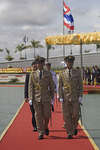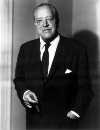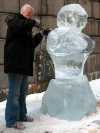 Charles I was King of England, Scotland and Ireland from March 27, 1625, until his execution in 1649. An advocate of the divine right of kings, Charles drew ire during his reign by engaging in a power struggle with Parliament, marrying a Catholic, and allying himself with controversial religious figures. His last years were marked by civil war, and he was defeated twice before being captured, tried, convicted, and executed for high treason. What happened after the monarchy was abolished? Discuss
Charles I was King of England, Scotland and Ireland from March 27, 1625, until his execution in 1649. An advocate of the divine right of kings, Charles drew ire during his reign by engaging in a power struggle with Parliament, marrying a Catholic, and allying himself with controversial religious figures. His last years were marked by civil war, and he was defeated twice before being captured, tried, convicted, and executed for high treason. What happened after the monarchy was abolished? Discuss
Source: The Free Dictionary
 Charles I was King of England, Scotland and Ireland from March 27, 1625, until his execution in 1649. An advocate of the divine right of kings, Charles drew ire during his reign by engaging in a power struggle with Parliament, marrying a Catholic, and allying himself with controversial religious figures. His last years were marked by civil war, and he was defeated twice before being captured, tried, convicted, and executed for high treason. What happened after the monarchy was abolished?
Charles I was King of England, Scotland and Ireland from March 27, 1625, until his execution in 1649. An advocate of the divine right of kings, Charles drew ire during his reign by engaging in a power struggle with Parliament, marrying a Catholic, and allying himself with controversial religious figures. His last years were marked by civil war, and he was defeated twice before being captured, tried, convicted, and executed for high treason. What happened after the monarchy was abolished?  Throughout most of the 1800s, the Union of Myanmar, known as
Throughout most of the 1800s, the Union of Myanmar, known as  A pioneer of modern architecture and one of its most influential figures, German-American architect Ludwig Mies van der Rohe was famous for his use of the minimalist architectural dictum “less is more.” As a young architect in Berlin, he foreshadowed modern architecture with innovative designs for tubular-steel furniture and steel-and-glass skyscrapers, and countless modernist steel-and-glass structures have been influenced by his work. Mies was also known for using what other famous aphorism?
A pioneer of modern architecture and one of its most influential figures, German-American architect Ludwig Mies van der Rohe was famous for his use of the minimalist architectural dictum “less is more.” As a young architect in Berlin, he foreshadowed modern architecture with innovative designs for tubular-steel furniture and steel-and-glass skyscrapers, and countless modernist steel-and-glass structures have been influenced by his work. Mies was also known for using what other famous aphorism?  Wallpaper was used in Europe in the 16th and 17th century as an inexpensive substitute for costly hangings. Outlines were block-printed, and the color was filled in with brush or stencil. The flock technique of printing designs with an adhesive and sprinkling with fine bits of wool or silk was probably first adapted to wallpaper around 1620 in France, but, by the 18th century, England had become principal wallpaper manufacturer. When did the wallpaper craze reach the American colonies?
Wallpaper was used in Europe in the 16th and 17th century as an inexpensive substitute for costly hangings. Outlines were block-printed, and the color was filled in with brush or stencil. The flock technique of printing designs with an adhesive and sprinkling with fine bits of wool or silk was probably first adapted to wallpaper around 1620 in France, but, by the 18th century, England had become principal wallpaper manufacturer. When did the wallpaper craze reach the American colonies?  The Bangladesh Liberation War was fought between West Pakistan and East Pakistan—now Pakistan and Bangladesh, respectively. It began as an uprising in East Pakistan led by a guerilla force called the Mukti Bahini. Indian support bolstered the Bangladeshi rebellion and led to a separate but simultaneous war between India and Pakistan. Eventually, West Pakistan’s forces were defeated and East Pakistan gained its independence, becoming the new nation of Bangladesh. Why did India support the rebels?
The Bangladesh Liberation War was fought between West Pakistan and East Pakistan—now Pakistan and Bangladesh, respectively. It began as an uprising in East Pakistan led by a guerilla force called the Mukti Bahini. Indian support bolstered the Bangladeshi rebellion and led to a separate but simultaneous war between India and Pakistan. Eventually, West Pakistan’s forces were defeated and East Pakistan gained its independence, becoming the new nation of Bangladesh. Why did India support the rebels?  This public holiday celebrates the the declaration of independence of the state of Bangladesh on March 26, 1971. When India gained independence from Britain in 1947, the region that is now Bangladesh became
This public holiday celebrates the the declaration of independence of the state of Bangladesh on March 26, 1971. When India gained independence from Britain in 1947, the region that is now Bangladesh became  One of America’s foremost 20th-century playwrights and the author of more than 70 plays, Tennessee Williams achieved his first successes with The Glass Menagerie and A Streetcar Named Desire, for which he won the Pulitzer Prize in 1948. Noted for his scenes of high dramatic tension and brilliant, often lyrical dialogue, Williams received a Tony Award for 1950’s The Rose Tattoo and won another Pulitzer in 1955 for Cat on a Hot Tin Roof. What was his real first name?
One of America’s foremost 20th-century playwrights and the author of more than 70 plays, Tennessee Williams achieved his first successes with The Glass Menagerie and A Streetcar Named Desire, for which he won the Pulitzer Prize in 1948. Noted for his scenes of high dramatic tension and brilliant, often lyrical dialogue, Williams received a Tony Award for 1950’s The Rose Tattoo and won another Pulitzer in 1955 for Cat on a Hot Tin Roof. What was his real first name?  Sculpting ice presents a number of difficulties stemming from the material’s variability with regard to purity and air content, as well as its tendency to melt. Ice sculptures feature decoratively in some cuisines, especially in Asia, and numerous competitions are held annually around the world where competitors sculpt realistic as well as abstract forms. In Kiruna, Sweden, a hotel made entirely of ice blocks is open from November to May. Where can you visit an ice hotel in North America?
Sculpting ice presents a number of difficulties stemming from the material’s variability with regard to purity and air content, as well as its tendency to melt. Ice sculptures feature decoratively in some cuisines, especially in Asia, and numerous competitions are held annually around the world where competitors sculpt realistic as well as abstract forms. In Kiruna, Sweden, a hotel made entirely of ice blocks is open from November to May. Where can you visit an ice hotel in North America?